Chronic low back pain, which affects millions of Americans each year, is often caused by a sedentary lifestyle and/or heavy use, which might sound a little like you’re damned if you do, and you’re damned if you don’t. But you’re not! There are many treatment options available to low back pain sufferers, ranging from medications to surgery. But one of the most sustainable and effective solutions for eliminating chronic low back pain is the (totally free!) regular practice of back-strengthening exercises.
There are several simple moves that (when practiced often) can reduce and eliminate low back pain by helping prevent weakness from inactivity and improving the body’s ability to tolerate activity as you get older.
The most important muscle groups to target include the back extensors and deep core stabilizers, abdominals, and glutes. It’s also important to keep the upper leg muscles strong and flexible in order to avoid strain on the supporting structures of the back. Movements that target these muscles should focus both on stabilization through the core and building endurance. Here, we outline five of the best moves you can do to keep your back healthy now and down the road.
5 Strength Exercises to Beat Back Pain
You can do these moves virtually anywhere to strengthen your back and core and support your lower back. The American College of Sports Medicine recommends doing functional training like these exercises two to three times per week for 20 to 30 minutes per session.
Try moving through the routine below, repeating each exercise 2 to 4 times. To be sure you reap all the back-boosting benefits, pay close attention to your form during every movement.
1. Decompression Breathing
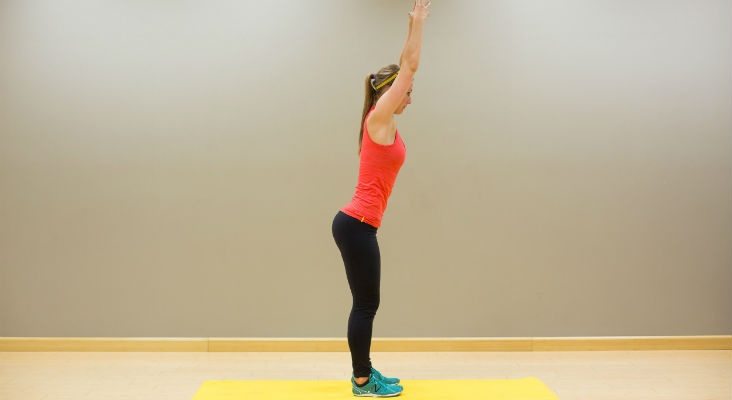 A little extra O2 can do a body good—especially when you’re lengthening the body at the same time! Use this move to teach yourself how to breathe deeply and keep your spine long and strong at all times.
A little extra O2 can do a body good—especially when you’re lengthening the body at the same time! Use this move to teach yourself how to breathe deeply and keep your spine long and strong at all times.
Stand with your toes touching and your heels slightly apart. Shift weight into your heels, unlock your knees, and gently pull your heels toward each other. Stand tall, reach your arms overhead, and press your fingertips together. With your inhale, lift the ribcage away from the hips. On the exhale, tighten the core to support the “lengthened” spine. Repeat this breathing process until you feel tall and supported.
2. Founder to Forward Fold
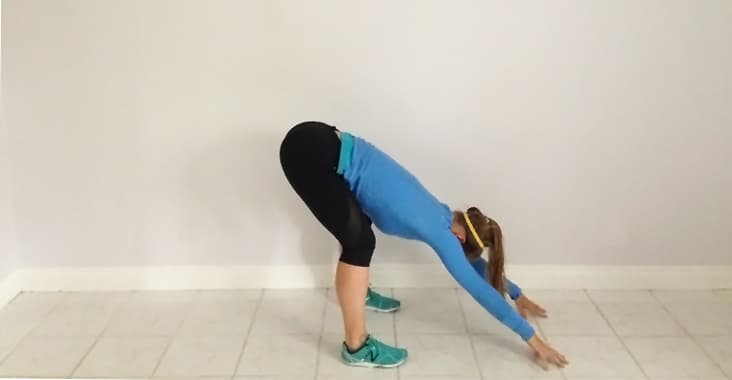 Sticking out your booty might feel embarrassing, but this move is called a founder because it’s setting you up for success in building integrated back and core strength. If a full founder puts too much tension on your lower back, try doing a modified founder with your hands back behind you (pictured below). If you’ve got tight hamstrings, use a prop (such as a chair) to help bring the ground just a wee bit closer to you. Remember—the goal is to reinforce good movement patterns. Use props or modify the full move if it helps you keep a neutral and stable spine.
Sticking out your booty might feel embarrassing, but this move is called a founder because it’s setting you up for success in building integrated back and core strength. If a full founder puts too much tension on your lower back, try doing a modified founder with your hands back behind you (pictured below). If you’ve got tight hamstrings, use a prop (such as a chair) to help bring the ground just a wee bit closer to you. Remember—the goal is to reinforce good movement patterns. Use props or modify the full move if it helps you keep a neutral and stable spine.
Modified Founder
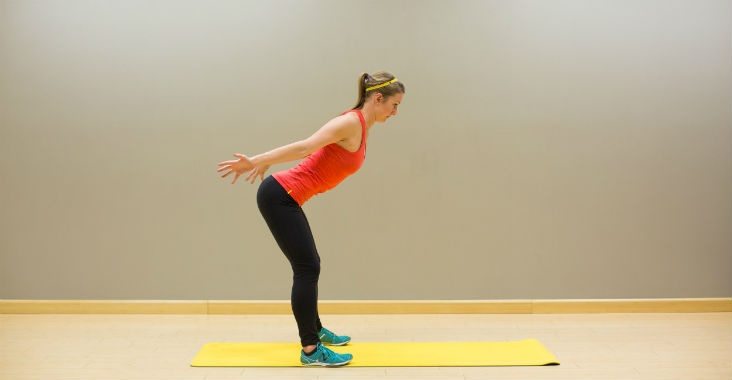 From the modified founder position, inhale and reach your arms out in front of your heart, keeping your hips back and pressing your fingertips together, with the pinkies pressing in the hardest. Slowly lift the arms all the way up, and keep the core pulled in to maintain a neutral spine. Hold 15 to 20 seconds.
From the modified founder position, inhale and reach your arms out in front of your heart, keeping your hips back and pressing your fingertips together, with the pinkies pressing in the hardest. Slowly lift the arms all the way up, and keep the core pulled in to maintain a neutral spine. Hold 15 to 20 seconds.
Forward Fold
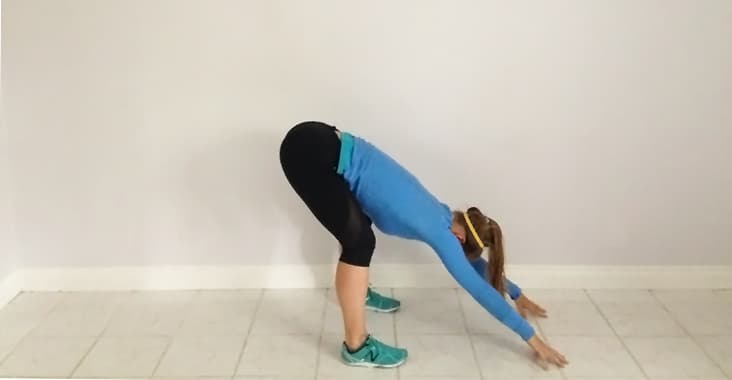 From full founder, float the hands down to the ground as you drive your hips back. Unlock your knees and keep the weight in your heels. When your hands are down to the ground (or on a prop, for people with tight hamstrings) pull your hips back, up, and away, reaching your hands as far forward as possible to counterbalance. Hold 20 to 30 seconds.
From full founder, float the hands down to the ground as you drive your hips back. Unlock your knees and keep the weight in your heels. When your hands are down to the ground (or on a prop, for people with tight hamstrings) pull your hips back, up, and away, reaching your hands as far forward as possible to counterbalance. Hold 20 to 30 seconds.
To stand up, keep your weight in your heels, slide your hands up your shins, and bring your spine into neutral. Sweep the arms back into Modified Founder position. Press the heels into the ground and bring your hips forward to stand up.
3. Adductor-Assisted Back Extension
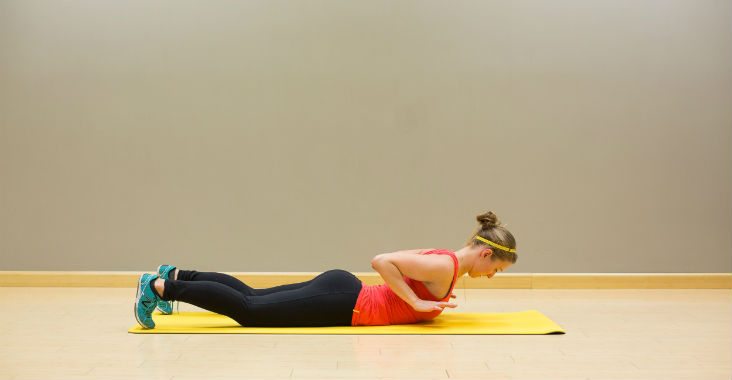 This well-known exercise isolates some of the deeper muscles of the lower back. Add in a little extra support from your inner thighs and some increased activation of the hamstrings, and you’ve got a recipe for building back muscles strong like a superhero’s.
This well-known exercise isolates some of the deeper muscles of the lower back. Add in a little extra support from your inner thighs and some increased activation of the hamstrings, and you’ve got a recipe for building back muscles strong like a superhero’s.
Start on the ground, lying on your stomach. Flex your feet and zip your legs together, keeping just a slight bend at the knees. Press your hips and knees into the ground and lift your elbows up until the hands “float” above the ground. Pull your shoulders down towards your butt while lifting your chest off the ground. Keep your neck long and hold the pose for 20 to 30 seconds.
4. Eight-Point Plank
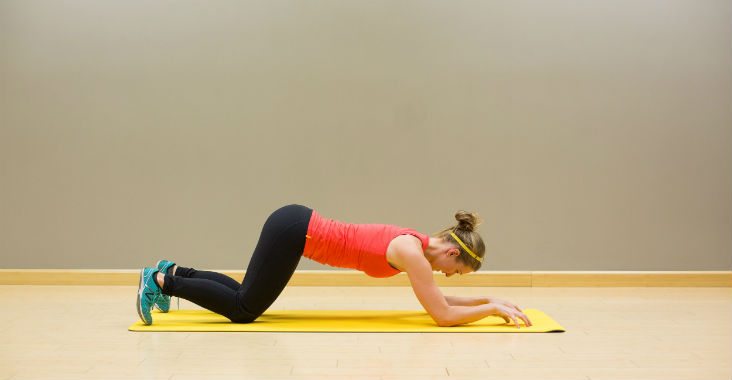 A plank with your elbows and knees on the ground sounds like it should be easy, but this one sure isn’t. Get ready to focus a bit more on your abs to create some serious support for your spine.
A plank with your elbows and knees on the ground sounds like it should be easy, but this one sure isn’t. Get ready to focus a bit more on your abs to create some serious support for your spine.
Lie on your stomach with your feet flexed, knees touching, and elbows a few inches in front of your shoulders. Pull your shoulders away from your ears, and gently squeeze the knees and elbows toward the centerline of body. Press knees, toes, and elbows into the mat as you lift your hips up to the height of the shoulders. Tighten your core and maintain a long, neutral spine. Pull the elbows and knees toward each other (as though you’re trying to bring the top and bottom of your mat together), and hold the plank for 20 to 30 seconds. If you begin to tremble, you’re doing this right.
5. Woodpecker
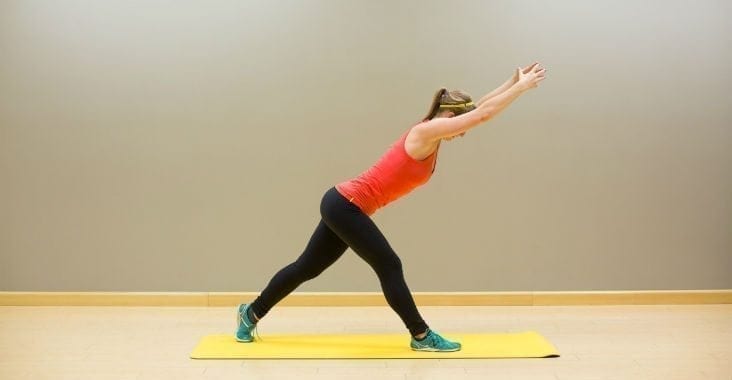 Named after the feisty little bird that tips forward when it hunts for food, this move will strengthen both your butt muscles and your back.
Named after the feisty little bird that tips forward when it hunts for food, this move will strengthen both your butt muscles and your back.
From a lunge position, press through your front heel and stand tall. Lift the back heel up off the ground and reach the arms out in front of your heart. Drive your butt as far back as you can, without moving your knee, until you feel a stretch in your hamstrings. Your arms will naturally reach further forward to counterbalance. Tighten your core, taking care to maintain a neutral spine, and slowly reach the arms overhead. Hold for 20 to 30 seconds, then repeat on the other side.
Modified Woodpecker
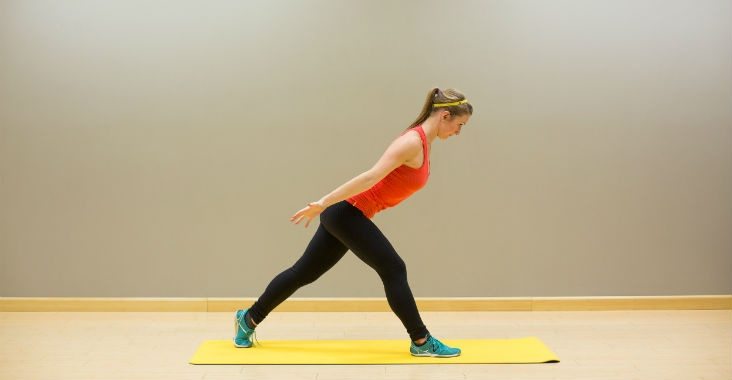 If a full woodpecker is too tough, try keeping your arms back behind you in a modified version while you build up the strength to perform the full version.
If a full woodpecker is too tough, try keeping your arms back behind you in a modified version while you build up the strength to perform the full version.
The Takeaway
Research shows that frequently bracing the core and strengthening your back muscles can be effective in promoting long-term relief from chronic low back pain. Meanwhile, sedentary behavior has been shown to be a health risk in and of itself itself—so next time you catch yourself sitting for a long period of time, stand up and do some Decompression Breathing, a Founder, or any of the exercises outlined above. You’ll give your body a break from sitting, and you’ll be working the muscles that support your spine. With a practice and minimal time commitment, a strong and supple back can be yours for the long haul!
Beth Alexander is a California-based personal trainer with a passion for teaching proper posture and movement patterns. Certified through both the National Academy of Sports Medicine and the American Council On Exercise, her specialty is integrated movement—teaching people to use muscles to work together for healthy functional movements. To learn more about Beth, visit her website or follow her on Facebook or Twitter.
All referenced postures were created by Dr. Eric Goodman, creator of Foundation Training, a series of bodyweight exercises designed to strengthens the posterior chain of muscles. Foundation Training includes several simple moves that (when practiced often) can reduce and eliminate low back pain by helping prevent weakness and inactivity and improving the body’s ability to tolerate activity over time. For more information about Foundation Training, visit the website.
Images courtesy of Greatist.



